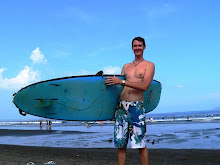
However, as with most Asian countries, marketing itself to Western tourists has fallen short, mostly because it takes decades for the concerned ministries to understand that Westerners in general speak English, either as first or second language. I am not saying that English is better in a way of form, but it is the lingua franca of the West.

Erosion caused by wind and waves (Just think of all those typhoons every year!) has sculpted formations out of rocks to make interesting patterns and shapes.

The strange formation happens because of different strengths in the rock, so that the softer parts erode first.

Pedestrian arches connect the eroded beach. One walks along a narrow path with a beautiful view on both sides. Mineral deposits paint colorful stripes on the exposed rock.

A statue (not statute, Minister!) reminds us of the treacherous currents at places on the coast of Taiwan.
Although the situation is improving with many schools providing swim lessons, a huge chunk of Taiwanese society is unable to swim. Taiwan being an island, and the abundance of rivers make this a strange and dangerous state of affairs as Taiwanese like the rest of the world enjoy the pleasures of water.
The area provides opportunity for taking amazing photos.
Before descending to some of the most well-known shapes, called hoodoos, we see them grouped together. An elevated wooden pathway ensures that most people stay off the rock, minimizing erosion and defacing by tourists. The rocks also get very slippery in wet weather.
The face of Wanli. The shape, called The Queen's head is the unofficial emblem of the local town of Wanli. One can clearly see how hoodoos are formed. The head looks a lot harder than the neck, so that eventually the neck will wear through and decapitate the queen.







No comments:
Post a Comment